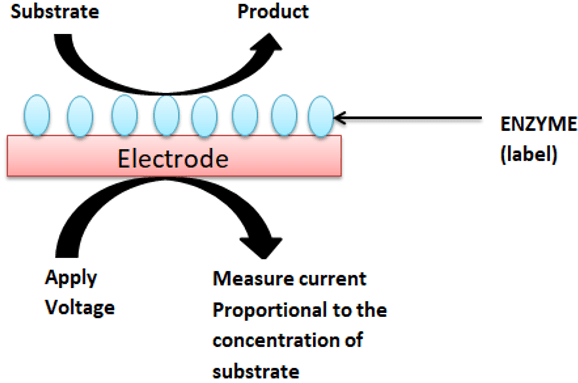This set of Tissue Engineering Multiple Choice Questions & Answers (MCQs) focuses on “Spectroscopic Biosensing Techniques”.
1. Which biosensor’s principle has been represented in following diagram?

a) Electrochemical biosensors
b) Optical biosensors
c) Electronic biosensors
d) Piezoelectric biosensors
View Answer
Explanation: Electrochemical biosensors are ordinarily founded on enzymatic catalysis of a response that produces or expends electrons (such proteins are properly called redox catalysts). The sensor substrate more often than not contains three cathodes; a reference terminal, a working anode and a counter anode.
2. Impedance spectroscopy measures the resistance and capacitance properties of material via application of a ______________ air conditioning excitation signal of c. 2–10 mV.
a) sinusoidal
b) linear
c) exponential
d) declining
View Answer
Explanation: Electrochemical impedance spectroscopy. Impedance spectroscopy estimates the opposition and capacitance properties of material by means of use of a sinusoidal air conditioning excitation sign of c. 2–10 mV. An impedance range is gotten by differing recurrence over a characterized range.
3. _________ spectroscopy is based on the interaction of an external field with the electric dipole moment of the sample, often expressed by the permittivity.
a) Dielectric
b) Capacitor
c) Transducer
d) Electrochemical
View Answer
Explanation: Dielectric spectroscopy estimates the dielectric properties of a medium as a component of recurrence. It depends on the cooperation of an outside field with the electric dipole snapshot of the example, regularly communicated by the permittivity. It is additionally a trial technique for portraying electrochemical frameworks.
4. Atomic polarization is observed when the nucleus of the atom reorients in response to the electric field.
a) TRUE
b) FALSE
View Answer
Explanation: Atomic polarization is seen when the core of the iota reorients because of the electric field. This is a resounding procedure. Nuclear polarization is characteristic for the idea of the iota and is an outcome of a connected field. Electronic polarization alludes to the electron thickness and is a result of a connected field. Nuclear polarization is normally little contrasted with electronic polarization.
5. ______________ relaxation as a whole is the result of the movement of dipoles (dipole relaxation) and electric charges (ionic relaxation) due to an applied alternating field.
a) Dielectric
b) Capacitor
c) Transducer
d) Electrochemical
View Answer
Explanation: Dielectric relaxation, in general, is the consequence of the development of dipoles (dipole unwinding) and electric charges (ionic unwinding) because of a connected substituting field and is normally seen in the recurrence run 102-1010 Hz. Unwinding components are moderately moderate contrasted with full electronic changes or atomic vibrations, which more often than not have frequencies over 1012 Hz.
6. Atomic polarization is observed when the nucleus of the atom reorients in response to the electric field.
a) TRUE
b) FALSE
View Answer
Explanation: Atomic polarization is seen when the core of the particle reorients because of the electric field. This is a resounding procedure. Nuclear polarization is characteristic for the idea of the molecule and is an outcome of a connected field. Electronic polarization alludes to the electron thickness and is an outcome of a connected field. Atomic polarization is typically little contrasted with electronic polarization.
7. Debye relaxation is the dielectric relaxation response of an ideal, noninteracting population of dipoles to an alternating external electric field.
a) TRUE
b) FALSE
View Answer
Explanation: Debye relaxation is the dielectric unwinding reaction of a perfect, non-interacting populace of dipoles to an exchanging outside electric field. It is generally communicated in the intricate permittivity ε of a medium as a component of the field’s frequency ω.
8. _______________ relaxation comprises ionic conductivity and interfacial and space charge relaxation.
a) Ionic
b) Dielectric
c) Conductive
d) Spectroscopic
View Answer
Explanation: Ionic relaxation contains ionic conductivity and interfacial and space charge unwinding. Ionic conductivity prevails at low frequencies and acquaints just misfortunes with the framework. Interfacial unwinding happens when charge transporters are caught at interfaces of heterogeneous frameworks. A related impact is Maxwell-Wagner-Sillars polarization, where charge transporters obstructed at inward dielectric limit layers (on the mesoscopic scale) or outside terminals (on a plainly visible scale) lead to a detachment of charges.
9. __________ is the ability of many materials (specifically ceramics) to become polarized under an applied electric field.
a) Paraelectricity
b) Ferrielectrecity
c) Neitrielectricity
d) Dielectricity
View Answer
Explanation: Paraelectricity is the capacity of numerous materials (specifically pottery) to move toward becoming spellbound under a connected electric field. In contrast to ferroelectricity, this can happen regardless of whether there is no changeless electric dipole that exists in the material, and evacuation of the fields brings about the polarization in the material coming back to zero. The systems that reason paraelectric conduct are the mutilation of individual particles (uprooting of the electron cloud from the core) and polarization of atoms or blends of particles or imperfections.
10. A dielectric resonator oscillator (DRO) is an electronic component that exhibits resonance of the polarization response for a narrow range of frequencies, generally in the microwave band.
a) Dielectric resonator oscillator
b) Armstrong Oscillator
c) Crystal Oscillator
d) Hartley oscillator
View Answer
Explanation: A dielectric resonator oscillator (DRO) is an electronic part that displays the reverberation of the polarization reaction for a thin scope of frequencies, for the most part in the microwave band. It comprises of a “puck” of earthenware that has a huge dielectric consistent and a low dissemination factor. Such resonators are regularly used to give a recurrence reference in an oscillator circuit. An unshielded dielectric resonator can be utilized as a dielectric resonator antenna (DRA).
Sanfoundry Global Education & Learning Series – Tissue Engineering.
To practice all areas of Tissue Engineering, here is complete set of 1000+ Multiple Choice Questions and Answers.
If you find a mistake in question / option / answer, kindly take a screenshot and email to [email protected]
- Check Biotechnology Books
- Apply for Biotechnology Internship
- Check Tissue Engineering Books
- Practice Biotechnology MCQs
